I’m sold on the EGN mini skid steer, and you should be too. This compact powerhouse has transformed how I tackle landscaping and construction tasks, offering versatility and affordability that’s hard to beat.
Whether you’re a contractor, a small business owner, or a homeowner with big projects, this machine delivers the muscle you need without the hefty price tag of bigger brands.
In this article, I’ll share my firsthand experience, break down the pros and cons, offer maintenance tips, compare it to other brands, and answer common questions to help you decide if it’s right for you.
My Experience With The EGN Mini Skid Steer
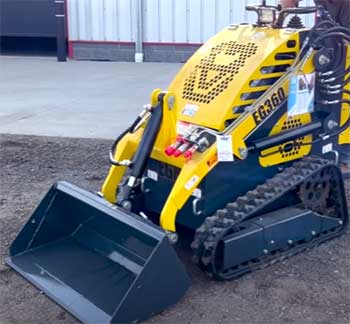
Let me take you back to the first time I fired up my EGN EG360 mini skid steer.
I’d been wrestling with a landscaping project at my property—a mix of moving gravel, leveling soil, and clearing debris in a tight backyard space.
Doing it by hand was backbreaking, and renting a full-sized skid steer felt like overkill for my small lot.
A friend recommended the EGN mini skid steer, and after some hesitation (mostly due to its Chinese manufacturing), I decided to give it a shot.
The price was a fraction of what I’d pay for a Bobcat or Kubota, so I figured I had little to lose.
When the EG360 arrived, I was immediately struck by its compact size. It’s small enough to fit through a standard garden gate, which was a game-changer for my project.
The 13.5 HP RATO gasoline engine roared to life with a reassuring hum, and I was surprised by how intuitive the joystick controls were. Within an hour, I was maneuvering it like a pro, scooping up dirt and hauling it across my yard.
The quick-attach bucket system let me swap to a grapple attachment for moving branches, and the auxiliary hydraulics handled it without a hiccup. I finished in half the time I’d planned, saving my back and my patience.
What stood out most was its versatility. I used it to trench for a drainage system, move mulch, and even drill holes with an auger attachment. The machine’s 900-pound lift capacity was more than enough for my needs, and its 6-inch tracks gave it solid traction on uneven terrain.
Sure, it’s not as polished as a premium brand, but for the price, it punched well above its weight. That said, I did notice some quirks—like a slightly clunky hydraulic response at times—which I’ll cover later.
Overall, my first project with the EGN left me impressed and eager to put it to work again.
Pros of The EGN Mini Skid Steer
- Affordability That Packs a Punch
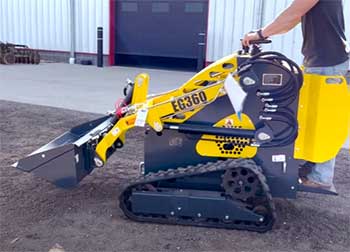
Let’s talk money first because, honestly, that’s what drew me to the EGN in the first place.
This machine is a budget-friendly steal compared to heavyweights like Bobcat or Toro.
I paid a fraction of the cost—around $6,500 for my EG360—while still getting a machine that handles most of my landscaping and small construction tasks.
For small business owners or homeowners like me, that kind of savings means you can invest in attachments or other tools without breaking the bank.
It’s not just cheap; it’s a smart investment for anyone who needs power without the premium price.
- Compact Design for Tight Spaces
The EGN’s compact size is a lifesaver. I’ve worked in spaces where a full-sized skid steer would be as useful as a tank in a closet. The EG360’s narrow frame and 6-inch tracks let me slip through a 36-inch gate and navigate around trees and fences with ease.
Whether you’re working in a backyard, a narrow alley, or a crowded construction site, this machine’s maneuverability is a huge advantage. It’s like having a Swiss Army knife for heavy lifting—small but mighty.
- Versatile Attachment Compatibility
One of the EGN’s biggest strengths is its compatibility with Toro Dingo-style attachments. I’ve used buckets, grapples, augers, and even a broom attachment, and the quick-attach system makes switching between them a breeze.
The auxiliary hydraulics are robust enough to power most attachments, which means you can tackle digging, grading, snow clearing, or debris removal with one machine. This versatility saved me from renting multiple pieces of equipment, and I’m betting it’ll do the same for you.
- Easy-to-Source Parts
When I first considered a Chinese-made machine, I worried about parts availability. But the EGN uses a RATO engine, essentially a Predator engine you can find at Harbor Freight.
That means replacement parts like filters, belts, or even engine components are easy to source locally or online. I’ve never had to wait more than a day or two for a part, which keeps downtime minimal.
For a budget machine, this kind of accessibility is a big win.
- Decent Power for Small Jobs
Don’t let the “mini” label fool you—the EGN has enough grunt for most small to medium tasks. With a 900-pound lift capacity and a 13.5 HP engine, it handled everything I threw at it, from moving gravel to lifting pallets of pavers.
It’s not going to compete with a 3,500-pound capacity Bobcat, but for residential projects or small-scale construction, it’s more than capable. I found it especially handy for tasks that would’ve taken hours by hand.
Cons of The EGN Mini Skid Steer
- Build Quality Could Be Better
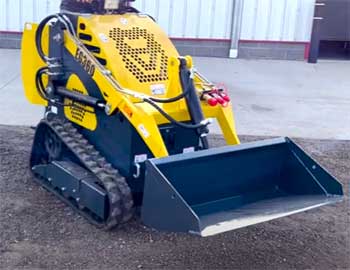
I’ll be honest—the EGN isn’t built like a tank.
After a few months of use, I noticed some wear on the hydraulic fittings and a bit of paint chipping on the frame.
The build quality isn’t on par with premium brands like Kubota or Caterpillar.
For example, the right work light on my EG360 arrived slightly bent, likely from shipping, and I’ve had to tighten some bolts more often than I’d like.
It’s not a dealbreaker, but you’ll need to baby it a bit more than a high-end model.
- Documentation Leaves You Guessing
One of my biggest gripes is the lack of a solid operator’s manual. The paperwork that came with my EG360 was sparse, with vague instructions and no clear maintenance schedule.
Figuring out things like hydraulic fluid replacement or troubleshooting error codes was a hassle. I ended up relying on online forums and my own trial-and-error, which isn’t ideal if you’re new to skid steers.
You’ll need to be comfortable doing some detective work or have a mechanic friend on speed dial.
- Hydraulic Performance Can Be Clunky
The hydraulics on the EGN are decent but not flawless. I’ve noticed occasional lag when switching between functions, like lowering the bucket while moving forward. It’s not a constant issue, but it can be frustrating when you’re trying to work quickly.
Compared to a Bobcat, the controls feel less refined, and the hydraulic flow isn’t as smooth. For light-duty tasks, it’s fine, but if you’re pushing the machine hard, you might notice the difference.
- Limited Dealer Support
Unlike big brands with sprawling dealer networks, EGN’s support is hit-or-miss. I bought mine through an online retailer, and while they were responsive enough, getting local service was tricky.
If you’re in a rural area, you might be on your own for repairs unless you’re handy with a wrench. This isn’t a huge issue if you’re proactive about maintenance, but it’s something to consider if you rely on dealer support for quick fixes.
Maintenance Tips For Your EGN Mini Skid Steer
- Keep the Hydraulic System Happy
The heart of your EGN mini skid steer is its hydraulic system, so treat it like royalty. I check the hydraulic fluid level every 50 hours of use, topping it off with the recommended ISO 46 hydraulic oil.
Every 200 hours, I replace the fluid entirely and swap out the filter to keep things running smoothly. If you notice sluggish performance, check for air in the system—bleeding the lines can make a big difference. Trust me, a little TLC here prevents costly repairs down the road.
- Clean It Like You Mean It
Mini skid steers like the EGN are prone to picking up dirt, especially in muddy or dusty conditions. After every job, I hose down the undercarriage and tracks to prevent debris from clogging the rollers or damaging the hydraulics.
A pressure washer is your best friend here, but be careful not to blast the electrical components. Keeping it clean not only extends the machine’s life but also makes it easier to spot leaks or loose parts.
- Check Tracks and Tension Regularly
The 6-inch tracks on the EG360 are great for traction, but they need regular attention. I check the track tension every 25 hours of use to ensure they’re not too loose or tight, which can wear them out faster.
Look for cracks or cuts in the rubber, and replace damaged tracks pronto to avoid damaging the rollers. A quick walk-around before each use can catch issues early and save you a headache.
- Engine Maintenance Is Non-Negotiable
Since the EGN uses a RATO engine, maintenance is straightforward but critical. I change the oil every 100 hours using 10W-30 and replace the air filter every 200 hours or sooner if I’m working in dusty conditions. Spark plugs get swapped out annually to keep the engine purring.
If you’re not sure where to start, grab a basic engine maintenance kit from Harbor Freight—it’s got everything you need.
- Store It Properly
When I’m not using my EGN, I store it in a dry garage to protect it from rust and weather damage. If you don’t have indoor storage, invest in a heavy-duty cover to shield it from rain and sun.
Before parking it for a long period, I disconnect the battery to prevent drainage and lower the bucket to relieve pressure on the hydraulics. These small steps go a long way in keeping your machine ready for action.
Comparison of EGN Mini Skid Steer With Other Brands
- EGN Vs. KIOTI Skid Steer
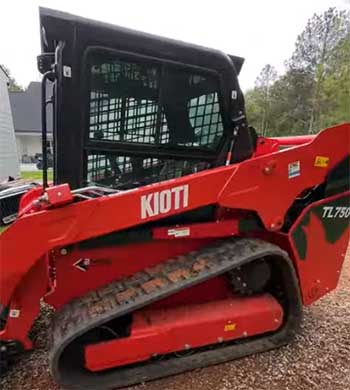
Let’s pit the EGN EG360 against KIOTI’s KSL1200 mini skid steer.
I got a chance to try a KIOTI at a local dealer, and it’s a solid machine with a 24.5 HP diesel engine that gives it more grunt than the EGN’s 13.5 HP gasoline engine.
The KIOTI feels sturdier, with tighter welds and a more polished finish, which makes sense given its $15,000 price tag—over twice the EGN’s cost.
Its hydraulic system is smoother, especially for heavy attachments like trenchers, and the controls have a premium feel.
However, the EGN’s compact size and Toro Dingo-style attachment compatibility make it more versatile for tight spaces and budget-friendly projects. KIOTI’s parts are less common, so maintenance can be pricier and slower compared to the EGN’s widely available RATO engine components.
If you’re a professional needing daily reliability, KIOTI’s power and build might be worth the splurge, but for occasional use, the EGN’s affordability and accessibility win out.
- EGN Vs. AGT Mini Skid Steer
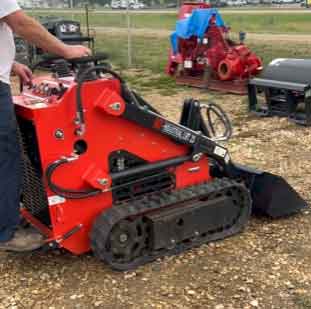
Next up is the AGT YF360, another Chinese-made mini skid steer that’s a direct competitor to the EGN.
I’ve talked to a contractor who owns an AGT, and it’s a close match in price—around $7,000—and performance.
Both machines have similar 13.5 HP engines (AGT often uses Briggs & Stratton), and they share comparable lift capacities, with the AGT edging out slightly at 950 pounds.
The AGT’s build quality feels marginally better, with fewer reports of loose fittings, but its attachment system isn’t as universal as the EGN’s Toro Dingo compatibility, which limits its versatility.
Parts for the AGT are easy to find, much like the EGN, but I’ve heard mixed reviews about AGT’s customer service. The EGN’s edge lies in its slightly lower cost and broader attachment options, making it a better pick for varied tasks, though AGT is a strong alternative if you prioritize engine brand reputation.
- EGN Vs. Wacker Neuson Skid Steer
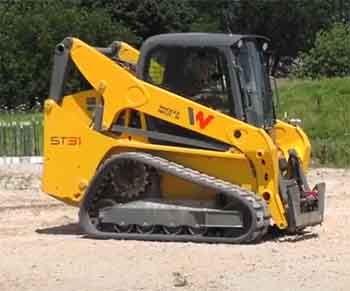
Finally, let’s compare the EGN to Wacker Neuson’s SM100 mini skid steer.
I saw one in action at a construction site, and it’s a beast with a 24 HP Honda engine and a 1,000-pound lift capacity.
Priced around $18,000, the Wacker Neuson feels like a luxury model next to the EGN, with superior hydraulics and a rock-solid frame that’s built for heavy-duty work.
Its controls are incredibly responsive, and the dealer network offers solid support, unlike the EGN’s limited service options.
However, the EGN’s compact design makes it better for squeezing into tight spaces, and its $6,500 price tag is hard to argue with.
For small businesses or homeowners like me, the EGN’s affordability and decent power make it a practical choice, while the Wacker Neuson is better suited for pros who need top-tier performance and don’t mind the cost.
Frequently Asked Questions (FAQ)
EGN skid steers are manufactured in China, which is a big reason for their affordability. While some folks hesitate about Chinese-made equipment, I’ve found the EG360 to be reliable for its price point. The RATO engine, similar to Predator engines sold in the U.S., makes sourcing parts straightforward, which eases concerns about quality and maintenance.
For me, the EGN mini skid steer was absolutely worth it. If you’re tackling landscaping, small construction, or farming tasks, it saves time and labor compared to manual work. The low upfront cost—around $6,500 for the EG360—makes it accessible, and its versatility with attachments adds value. Just be ready to handle minor maintenance yourself, as dealer support can be spotty.
From my experience and research, the EGN offers great reliability for its price, especially for light to medium tasks. However, if you need top-tier durability, Bobcat’s models like the S770 are hard to beat, though they cost significantly more. For budget buyers, the EGN’s balance of affordability, power, and parts availability makes it a strong contender.
It’s tough to crown one brand, but I’d put EGN near the top for its value and versatility. AGT is another Chinese brand that gets praise for using common components like Briggs & Stratton engines, which simplifies maintenance. EGN stands out for its Toro Dingo attachment compatibility and accessible parts, making it a practical choice for contractors and homeowners alike.
Conclusion: Why The EGN Mini Skid Steer Is A Smart Buy?
If you’re looking for a compact, versatile, and budget-friendly machine, the EGN mini skid steer is a no-brainer. It’s transformed how I handle landscaping and small construction projects, saving me time, money, and effort.
Despite some quirks, its affordability, maneuverability, and attachment compatibility make it a standout choice. Whether you’re a homeowner or a small business owner, this machine delivers where it counts.
Give it a shot—you won’t regret adding this powerhouse to your toolkit.
